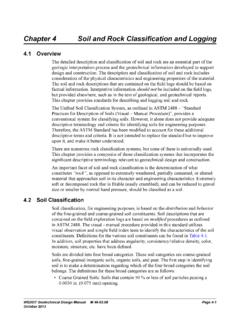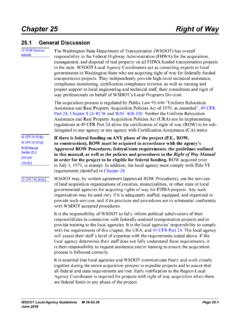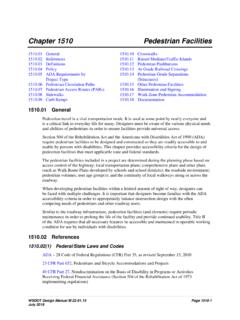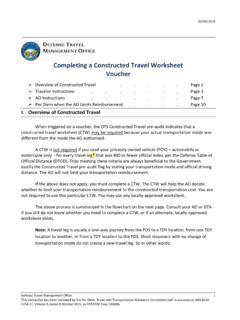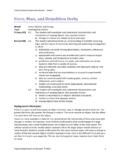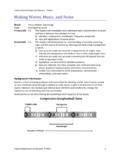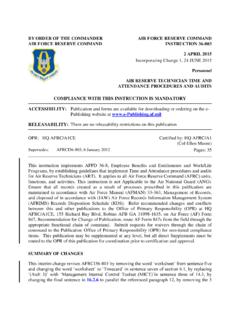Transcription of Chapter 4 Bases - Washington State Department of ...
1 Chapter 4 Bases 4-02 Gravel base GEN General Instructions Gravel base is typically used in the construction of the roadway section and provides support for the pavement. For the pavement to provide a long life, it is important the gravel base be placed uniformly and compacted properly. SS Construction Requirements When gravel base is specified in the contract, the Contractor may request, in writing, that gravel borrow be used in lieu of gravel base . When gravel borrow is substituted for gravel base , the top ft of gravel borrow shall be replaced with ft of crushed surfacing top course (CSTC).
2 Testing and sampling frequencies will be as required for the material actually placed. The CSTC and gravel borrow used in lieu of the gravel base is measured and paid for as gravel base and not as CSTC or gravel borrow. The inspector should note on the item quantity ticket that the CSTC or gravel borrow is being used in lieu of gravel base . The as built plans will identify sections where gravel borrow and CSTC were substituted for gravel base . 4-04 Ballast and Crushed Surfacing GEN General Instructions Ballast and crushed surfacing is used in the construction of the roadway section and provides support for the pavement.
3 Ballast may be naturally occurring or manufactured, crushed surfacing is a manufactured material. Careful inspection during the manufacturing process is required to verify that the material meets the contract specifications. This is important so the material will have the properties needed to provide support to the pavement and drain water from beneath it. For the pavement to provide a long life, it is important that ballast or crushed surfacing be placed uniformly to the line, grade, and cross section specified in the plans and compacted properly.
4 Staking See Section 1-05 for listed tolerance and the Highway Surveying Manual M 22-97 for additional instruction concerning staking. GEN Inspector's Checklist Inspection duties include but are not limited to: 1. Watch for segregation of material on roadway. Make sure each course of surfacing is properly prepared and meets density specifications before allowing the next course to be placed. 3. When applying water to a surfacing course, see that it is distributed evenly over the entire course. Avoid over-watering which may cause soft spots in subgrade.
5 4. Make frequent checks of yield to see that the specified quantity of material is placed. WSDOT Construction Manual M Page 4-1. March 2019. Chapter 4 Bases 5. See that surfacing courses are completed and compacted true to profile and section. See that humps and sags in the profile are removed. 6. See that surfacing is maintained properly. Should irregularities develop in any surfacing the contractor shall repair the defects prior to placement of the next course. 7. Make depth checks to ensure conformance with the roadway section.
6 8. Make daily moisture checks on material paid for by the ton when excess moisture is present. 9. Make sure that adequate survey hubs are used in order to verify that the grade will be smooth and uniform. SS Construction Requirements SS (2) Subgrade Subgrade for ballast or crushed surfacing is prepared in accordance with the appropriate specifications. Any soft or spongy areas shall be removed or stabilized before the ballast or surfacing material is placed over it. SS (3) Mixing The Standard Specifications require the material to be mixed by the Central Plant Mix Method, the Road Mix Method, or a combination of the two methods.
7 On some projects, the Central Plant Mix Method is the required method. SS (4) Placing and Spreading Ballast and crushed surfacing materials shall be hauled and placed on the roadway with the equipment and in accordance with the Standard Specifications. It is imperative that the Inspector watch for segregation of materials during all stages of hauling and placement. The design of the roadway section is based on all materials meeting all requirements of the specifications, including gradation requirements. If crushed surfacing materials are deposited on the roadway in a segregated condition, the only corrective measure available is processing of the material on the roadway, using motor graders or other mixing equipment.
8 Excessive processing of material on the roadway is a poor substitute for placement of material in the proper condition in the first place. Therefore, it is very important that every effort be made to ensure correct handling of the materials at all stages of surfacing operations. Various types of equipment have been developed in order to facilitate placing the required amount of material with a minimum of segregation to the correct cross-section. When the material is mixed with water in a central plant before placing on the roadway with a spreading machine, it can be compacted and shaped to the proper grade and cross-section with a minimum of handling and shaping on the roadway.
9 Some equipment operates from grade control wires to ensure the material is placed at the proper elevation and transverse slope. If this type of operation is proposed to be used by the Contractor, the Inspector should become familiar with the operation and intricacies of the equipment. Before each course of surfacing is placed, the Inspector should verify that the underlying course is uniformly graded and compacted properly. The Inspector should also see that each course is finished to a true, smooth profile with no humps or hollows.
10 A good way to locate irregularities in the roadway profile or crown is by careful visual inspection. Viewing Page 4-2 WSDOT Construction Manual M March 2019. Bases Chapter 4. the grade from a prone position or using stringlines between hubs may be helpful. In this way, additional material can be spot-placed to eliminate low and irregular areas, and the material graded and compacted to a true, smooth surface. It is important the Contractor place the courses of surfacing material in such a manner as to minimize any deleterious effect on the quality of the material already placed.






